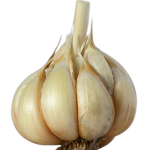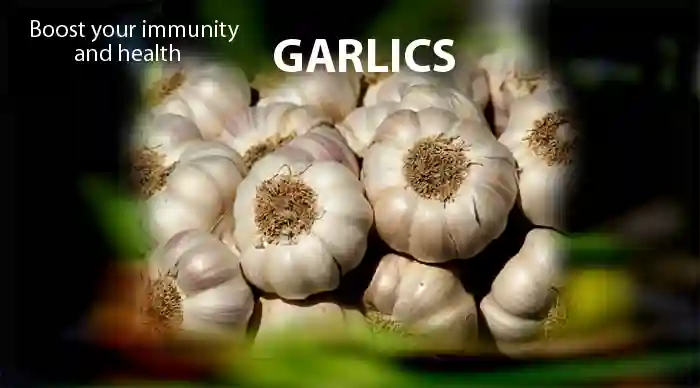The Garlic: A Detailed Exploration of Its History, Health Benefits, and Culinary Uses

The Garlic: An Overview
The history of garlic extends across numerous civilizations and goes back thousands of years. Garlic originated in Central Asia and soon expanded over the world, becoming a common ingredient in many different cuisines. Garlic was believed to improve strength and endurance, so workers and soldiers in ancient Egypt consumed it. It was even buried with Tutankhamun as a sacrifice. Garlic was also prized by the ancient Greeks and Romans for its culinary and medicinal properties.
Garlic was employed as a popular cure-all and a means of warding off plagues and evil spirits during the Middle Ages. In Renaissance Europe, its therapeutic qualities were still highly regarded, since it was thought to be a panacea for anything from stomach problems and controlling cholesterol, strengthening the heart, bolstering the immune system, warding off colds, and more.. Garlic is still a common ingredient in kitchens around the world today because of its strong flavor and adaptability.
Nutritional Benefits of Garlic
Despite its diminutive size, garlic has a lot of nutrients. Garlic is a rich source of vitamins and minerals, including high concentrations of vitamin C, vitamin B6, and manganese. Additionally, it has trace levels of other vital elements like phosphorus, potassium, and calcium. Allicin, the main active ingredient in garlic, is what gives it its distinct fragrance and a host of health advantages.
Garlic is low in calories and high in flavour, so it’s a great addition to a balanced diet. Additionally, it contains antioxidants, which support the body’s defence against oxidative stress and free radical damage
Health Benefits of Garlic
Garlic’s reputation as a natural remedy is well-deserved, thanks to its numerous health benefits. Here are some of the ways garlic can positively impact your health:
- Boosts Immunity: Garlic has been shown to enhance the immune system’s function, helping the body fight off infections and illnesses.
- Reduces Blood Pressure: Studies have suggested that garlic can help lower blood pressure, reducing the risk of heart disease.
- Lowers Cholesterol Levels: A 2018 study Trusted Source found that garlic can help reduce total and low-density lipoprotein (LDL), or “bad” cholesterol. This may aid in cholesterol management, which may improve heart health.
- Fights Infections: Garlic’s antimicrobial properties make it effective against various types of bacteria, viruses, and fungi.
- Supports Bone Health: In a brief 2017 study Garlic pills and raw garlic have been shown to enhance calcium absorption, according to Trusted Source.
so garlic controls and lowers the risk of Osteoporosis.
6. Anti-inflammatory Effects: Garlic has been found to have anti-inflammatory properties, potentially helping to reduce inflammation in the body

Culinary Uses of Garlic
Garlic is a versatile component in the kitchen because of its strong flavour and scent. It is delicious with meats, vegetables, grains, and legumes and can be used raw, roasted, minced, or powdered. Here are a few common culinary uses for garlic:
Seasoning:
Garlic gives marinades, salads, and sauces more flavour and depth. It’s a mainstay in meals like soups, stir-fries, and pasta sauces.
Roasted Garlic:
The flavour of garlic becomes sweeter and nutty after roasting. It adds a delectable flavour to mashed potatoes or can be spread over bread.
Garlic Oil:
A quick and easy technique to flavour food is to infuse oil with garlic. You can use it to sauté seafood, meats, and veggies.
Garlic Powder and Granules:
These handy garlic products don’t need peeling and chopping raw garlic; instead, you simply sprinkle them on dishes for a flavorful kick.
Garlic Bread:
Made by spreading a mixture of garlic, butter, and herbs over bread and toasting it, garlic bread is a traditional and adored side dish
Types of Garlic
There are various types of garlic, and each has a distinct flavour and set of properties. Hardneck and softneck garlic are the two main varieties.
Hardneck garlic:
This type bears a blossom head on a strong central stalk known as a scape. Larger cloves and a deeper, richer flavour are characteristics of hardneck garlic.
Softneck garlic:
It is simpler to braid and store because of its flexible stem. Compared to hardneck types, it contains fewer cloves and a softer flavour.
Growing Garlic at Home
It’s a satisfying experience to grow your garlic, and it will save you money on fresh garlic. This is how to begin:
Select the Correct Variety:
Choose a garlic variety that is appropriate for your growing environment and climate. Hardneck garlic is best suited for colder temperatures, whereas softneck garlic can thrive in a wider variety of environments.
Planting:
For a summer yield, plant garlic cloves in the autumn. Select a sunny spot with soil that drains properly. Plant the cloves 4–6 inches apart and 2 inches deep.
Mulching and Watering:
Give the garlic lots of water, especially in dry seasons. Mulch the area around the plants to keep moisture in and prevent weed growth.
Harvesting:
Garlic should be harvested when the lower leaves start to turn yellow and dry out. After carefully excavating the bulbs, let them cure for a few weeks in a dry, well-ventilated area.
Storage:
Keep cured garlic bulbs out of direct sunlight and in a cool, dry location. Garlic that is kept properly can keep for several months.

Storing Garlic
Garlic can keep its flavour and freshness for a long time if it is stored correctly. The following advice can help you store garlic:
Whole Bulbs:
Store whole garlic bulbs in an area that gets enough of air and is cold and dry. To prevent them from sprouting, do not store them in the refrigerator.
Cloves:
For optimal flavour, use separated garlic cloves within a few days of separation. Keep them somewhere cold and dark.
Minced Garlic:
For up to a week, keep minced garlic in the refrigerator in an airtight container
The Garlic in Different Cuisines
Italian cuisine
is incomplete without garlic, which gives meats, risotto, and pasta sauces more flavour. A classic example is pasta with garlic and oil, or aglio e olio.
Chinese:
Garlic is utilized in marinades, sauces, and stir-fries in Chinese cooking. For a tasty basis, it’s frequently combined with ginger and green onions.
Indian:
Known for its use in marinades, chutneys, and curries, garlic is a staple in Indian cuisine. It is frequently used to make rich, fragrant meals along with tomatoes, onions, and spices.
French:
Garlic is used in many different French recipes, such as stews, soups, and roasted meats. Garlic is a main ingredient in the traditional meal aioli.
Middle Eastern:
Garlic is frequently used in hummus, baba ganoush, and other dips and spreads in Middle Eastern cooking.
Myths and Misconceptions About Garlic
Despite all of its advantages, there are a lot of myths and false beliefs about garlic. Let’s talk about a few:
The Miracle Cure of Garlic:
Garlic is beneficial to health, but it’s not a miracle cure. Maintaining a balanced diet is crucial, and if you have any major health concerns, see a doctor.
Why Garlic Always Causes Bad Breath:
Although garlic has a strong smell, it can be lessened with the right preparation and cooking. Eating things like parsley can also help prevent garlic breath.
All Garlic Is the Same:
Garlic comes in a wide range of kinds, each with a distinct flavour and set of properties. Trying out several kinds will improve your cooking expertise.
Conclusion
The amazing ingredient garlic has won a spot in kitchens all across the world. Garlic is still a cherished staple in many countries because of its long history, numerous health advantages, and adaptability in the kitchen. Garlic may improve your culinary and general health whether you cultivate it yourself or buy it from a store. Here’s how to store and use it. Try a variety of recipes and kinds to see all the amazing ways garlic can improve your food
FAQs
- What are the different types of garlic? There are two main types of garlic: softneck and hardneck. Softneck garlic is more common and adaptable to various climates, while hardneck garlic is known for its robust flavor and is best suited for cooler regions.
- Can garlic cause side effects? In some cases, garlic can cause digestive issues, heartburn, or allergic reactions in sensitive individuals. Consuming large amounts of raw garlic can also lead to an upset stomach.
- How can I reduce garlic breath? Consuming foods like parsley, mint, or apples can help neutralize garlic breath. Brushing your teeth and tongue shortly after eating garlic can also help.
- Is garlic safe for pets? Garlic can be toxic to pets, particularly dogs and cats. It’s best to avoid feeding garlic to your pets.
- What are some garlic substitutes? If you’re out of garlic, onion, shallots, or chives can provide similar flavors in recipes. Garlic powder or granules can also be used as a convenient substitute.
Q. How can I preserve fresh garlic? You can preserve fresh garlic by freezing it in ice cube trays with olive oil, or by dehydrating it and grinding it into garlic powder.








